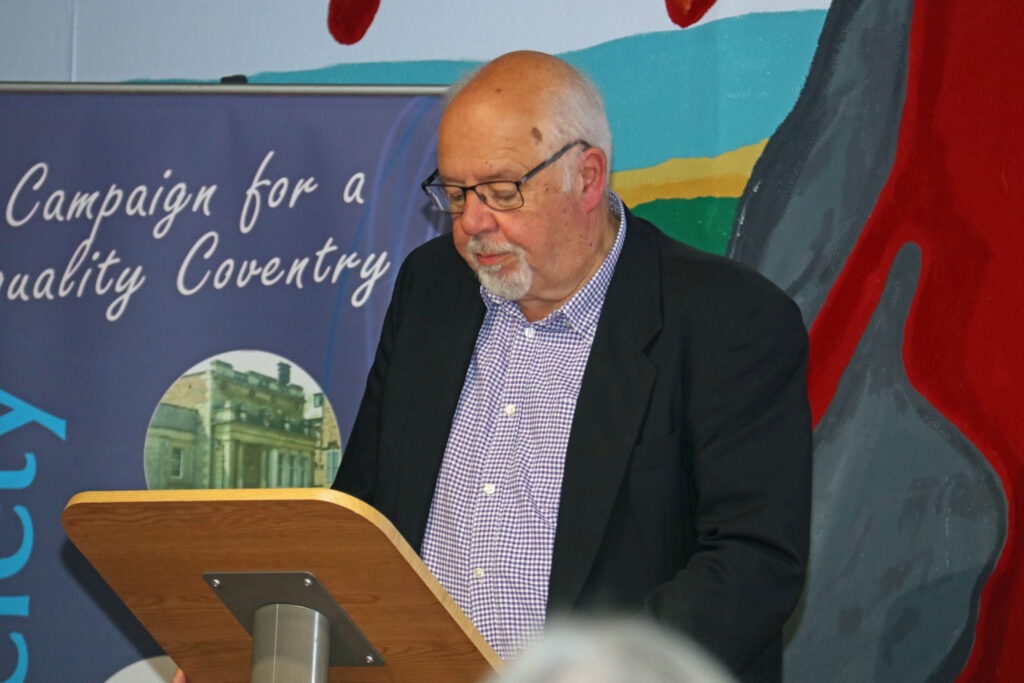
Coventry Society held its fifth annual Heritage Conference in October.
The City Heritage: Future Strategies conference, held at the Herbert Art Gallery & Museum on 18 October 2025, brought together seventy people including heritage leaders, civic representatives, and community organisations to discuss ongoing projects and future plans for Coventry’s historic and cultural landscape.
Opening Remarks
Marguerite Nugent, Cultural Director of Culture Coventry Trust, welcomed attendees and highlighted the Herbert’s current exhibitions, including the Coventry Biennial and Coventry’s Lost Library, alongside upcoming displays such as the Virk Archive exhibition focusing on Coventry’s immigrant experiences.
Historic Coventry Trust Update – Ian Harrabin
Ian outlined the Trust’s progress on key heritage restorations. At Charterhouse, collaboration with the National Trust has exceeded visitor targets, though further funds are required to complete the Pentice walkway. Drapers Hall continues to host public events, while The Burges awaits occupancy of its upper floors. Major environmental work continues with the River Sherbourne de-culverting project, though funding gaps remain. The Whitefriars Gate and London Road Cemetery Chapel projects need further investment to tackle internal restoration and access improvements. Looking ahead, Harrabin floated ambitious proposals including a Bailey Lane Tudor reconstruction and potential redevelopment of Whitefriars Monastery and Spon Street, though these depend on securing funding and addressing antisocial behaviour issues.
Coventry Heritage Strategy – Marcus Lynch
Marcus Lynch discussed the forthcoming Coventry Heritage Strategy, in development since 2020. The document aims to embed heritage considerations into city policy, structured around four themes: understanding, protecting, engaging, and promoting Coventry’s heritage. It will serve as a key reference for planners, partners, and community stakeholders.
IKEA Building Redevelopment – Charlotte Booth
Following IKEA’s 2020 closure, Coventry City Council acquired the building to create a multi-use cultural hub in partnership with the Arts Council, British Council, and Culture Coventry Trust. Coventry University will occupy the top two floors, while lower levels are being redeveloped for cultural and commercial use. With construction set to finish in 2026 and opening in 2027, the £5 million “levelling up” funded project promises major cultural benefits.
Reviving Spon Street – Tim Brown
CovSoc’s Deputy Chair, Tim Brown, called for a coherent strategy to revitalise the Spon Street Conservation Area, citing maintenance challenges and neglected properties. Opportunities lie in linking the area to the IKEA project and surrounding housing developments, but strategic planning and investment are essential.
Coventry Archives – Mike Bevan & Shaniece Martin
Mike introduced the Archives’ services, while Shaniece previewed Stories That Made Us, an exhibition based on the Virk Family Archive, chronicling Coventry’s South Asian community from the 1960s to today.
Irish Coventry Heritage – Caroline Brogan
Caroline Brogan highlighted the longstanding Irish influence in Coventry, from post-famine migration to postwar industrial work. The Coventry Irish Society (founded 1993) continues to support Irish heritage and community wellbeing through events, advocacy, and cultural activities.
Kenilworth Road Trees Project – Ray Wilson
Ray Wilson described volunteer efforts to restore the nineteenth-century Kenilworth Road tree avenue, clearing invasive growth and rediscovering historical features, transforming it into a welcoming green corridor.
Historic Environment Record – Sara Farey
Sara detailed updates to Coventry’s Historic Environment Record (HER)—a digital map of historic sites and finds—essential for both historians and planners.
Police Museum – Kevin Watson
Kevin Watson recounted the museum’s evolution, now located in the Old Council House and attracting strong public interest. Plans for relocation to the former police station site could further enhance public engagement.
National Trust at Charterhouse – Niamh Carton
Niamh Carton reported exceptional visitor numbers and ongoing partnerships aimed at broadening community engagement through projects like the Sherbourne Valley Green Corridor.
You can read or download a text report of the conference, with links to the individual presentations here, or a newsletter format report here. See photographs of the conference here.
